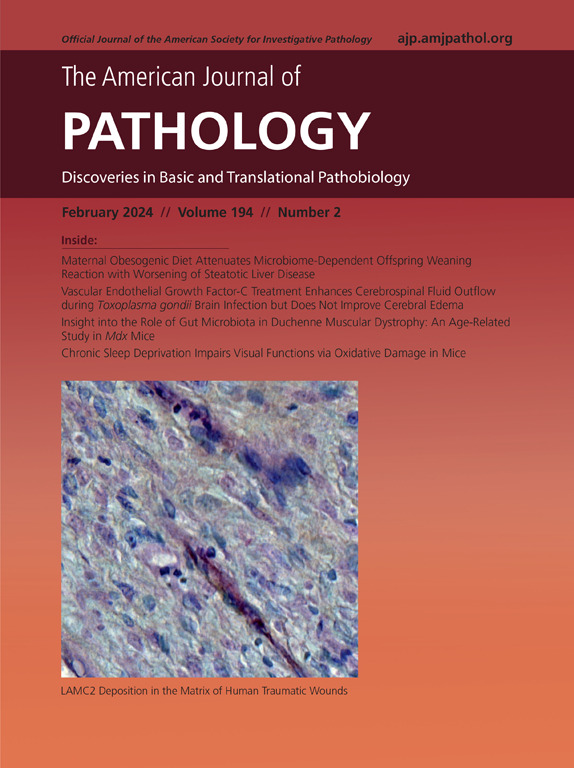Novel Perineural Pathways and the Dynamics of SIV-Infected Macrophage Trafficking Out of the Central Nervous System
IF 3.6
2区 医学
Q1 PATHOLOGY
引用次数: 0
Abstract
A challenge to eradicate HIV is the central nervous system (CNS) reservoir and unknown mechanisms-pathways by which infected macrophages can exit. We used intracisternal injection of superparamagnetic iron oxide nanoparticles (SPIONs), some of which had different internal immune fluorescence to define perineural pathways of SPION+ macrophage traffic in SIV-infected animals with AIDS, on antiretroviral therapy (ART) and with ART interruption. SPION+ macrophages are identified in central (spinal cord and cranial nerves) and peripheral (dorsal root ganglia) sites. In noninfected animals, SPION+ macrophages traffic out normally. With SIV infection, SPION+ macrophages accumulate in the CNS, and there are decreased numbers that traffic out. SIV-RNA and SIV-glycoprotein 41 (gp41) SPION+ macrophages are found in cranial nerves and dorsal root ganglion that are significantly reduced, but not eliminated, with ART. Using SPIONs with two different internal fluorescences, injected early and late after SIV infection, we find AIDS animals have greater numbers of early injected SPION+ macrophages within cranial nerves, consistent with reduced traffic late. With ART, there are greater numbers of late and dual (early and late) labeled SPION+ macrophages in the periphery, that return to levels found in AIDS animals following ART interruption. These findings reveal a novel pathway by which CNS macrophages can redistribute virus from the CNS to the periphery that persists despite ART.

新的神经周围通路和猴免疫缺陷病毒感染的巨噬细胞运输出中枢神经系统的动力学。
根除艾滋病毒的一个挑战是中枢神经系统的储存库和未知的机制-被感染的巨噬细胞可以退出的途径。我们采用腹腔注射超顺磁性氧化铁纳米颗粒(SPION),其中一些具有不同的内部免疫荧光,以确定SIV感染的艾滋病动物、抗逆转录病毒治疗和抗逆转录病毒治疗中断时SPION+巨噬细胞运输的神经周围通路。SPION+巨噬细胞见于中枢(脊髓和脑神经)和外周(背根神经节)部位。在未感染动物中,SPION+巨噬细胞正常输出。SIV感染时,SPION+巨噬细胞在中枢神经系统内积聚,流出的数量减少。在脑神经和DRG中发现SIV- RNA和gp41 SPION+巨噬细胞,ART显著减少,但未消除。通过在SIV感染早期和晚期注射两种不同内部荧光的SPION,我们发现艾滋病动物早期在脑神经内注射的SPION+巨噬细胞数量更多,与后期交通量减少一致。在抗逆转录病毒治疗中,外周有更多的晚期和双(早期和晚期)标记SPION+巨噬细胞,它们在抗逆转录病毒治疗中断后恢复到艾滋病动物的水平。这些发现揭示了一种新的途径,通过这种途径,中枢神经系统巨噬细胞可以将病毒从中枢神经系统重新分配到外周,尽管抗逆转录病毒疗法仍然存在。
本文章由计算机程序翻译,如有差异,请以英文原文为准。
求助全文
约1分钟内获得全文
求助全文
来源期刊
CiteScore
11.40
自引率
0.00%
发文量
178
审稿时长
30 days
期刊介绍:
The American Journal of Pathology, official journal of the American Society for Investigative Pathology, published by Elsevier, Inc., seeks high-quality original research reports, reviews, and commentaries related to the molecular and cellular basis of disease. The editors will consider basic, translational, and clinical investigations that directly address mechanisms of pathogenesis or provide a foundation for future mechanistic inquiries. Examples of such foundational investigations include data mining, identification of biomarkers, molecular pathology, and discovery research. Foundational studies that incorporate deep learning and artificial intelligence are also welcome. High priority is given to studies of human disease and relevant experimental models using molecular, cellular, and organismal approaches.

 求助内容:
求助内容: 应助结果提醒方式:
应助结果提醒方式:


